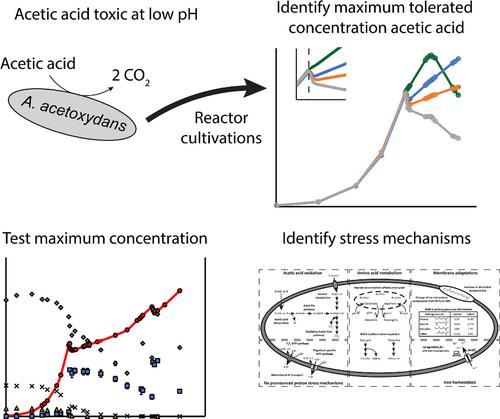当前位置:
X-MOL 学术
›
Environ. Microbiol.
›
论文详情
Our official English website, www.x-mol.net, welcomes your
feedback! (Note: you will need to create a separate account there.)
Acetic acid stress response of the acidophilic sulfate reducer Acididesulfobacillus acetoxydans
Environmental Microbiology ( IF 4.3 ) Pub Date : 2024-02-14 , DOI: 10.1111/1462-2920.16565 Reinier A Egas 1 , Diana X Sahonero-Canavesi 2 , Nicole J Bale 2 , Michel Koenen 2 , Çağlar Yildiz 1 , Laura Villanueva 2, 3 , Diana Z Sousa 1, 4 , Irene Sánchez-Andrea 1, 5
Environmental Microbiology ( IF 4.3 ) Pub Date : 2024-02-14 , DOI: 10.1111/1462-2920.16565 Reinier A Egas 1 , Diana X Sahonero-Canavesi 2 , Nicole J Bale 2 , Michel Koenen 2 , Çağlar Yildiz 1 , Laura Villanueva 2, 3 , Diana Z Sousa 1, 4 , Irene Sánchez-Andrea 1, 5
Affiliation

|
Acid mine drainage (AMD) waters are a severe environmental threat, due to their high metal content and low pH (pH <3). Current technologies treating AMD utilize neutrophilic sulfate-reducing microorganisms (SRMs), but acidophilic SRM could offer advantages. As AMDs are low in organics these processes require electron donor addition, which is often incompletely oxidized into organic acids (e.g., acetic acid). At low pH, acetic acid is undissociated and toxic to microorganisms. We investigated the stress response of the acetotrophic Acididesulfobacillus acetoxydans to acetic acid. A. acetoxydans was cultivated in bioreactors at pH 5.0 (optimum). For stress experiments, triplicate reactors were spiked until 7.5 mM of acetic acid and compared with (non-spiked) triplicate reactors for physiological, transcriptomic, and membrane lipid changes. After acetic acid spiking, the optical density initially dropped, followed by an adaptation phase during which growth resumed at a lower growth rate. Transcriptome analysis revealed a downregulation of genes involved in glutamate and aspartate synthesis following spiking. Membrane lipid analysis revealed a decrease in iso and anteiso fatty acid relative abundance; and an increase of acetyl-CoA as a fatty acid precursor. These adaptations allow A. acetoxydans to detoxify acetic acid, creating milder conditions for other microorganisms in AMD environments.
中文翻译:

嗜酸性硫酸盐还原剂Acideidesulfobacillus acetoxydans的乙酸胁迫反应
酸性矿井排水 (AMD) 水由于金属含量高和 pH 值低(pH <3 id=14>Acididesulfobacillus acetoxydans 转化为乙酸)而造成严重的环境威胁。A . acetoxydans在 pH 5.0(最佳)的生物反应器中培养。对于应激实验,一式三份反应器中添加了 7.5 mM 乙酸,并与(未添加)一式三份反应器进行了生理学、转录组和膜脂质变化的比较。添加乙酸后,光密度最初下降,随后进入适应阶段。在此期间,转录组分析显示参与谷氨酸和天冬氨酸合成的基因下调,膜脂质分析显示异和反异脂肪酸相对丰度减少,乙酰辅酶A 增加。这些适应性改变使得乙酰氧化酶能够解毒乙酸,为 AMD 环境中的其他微生物创造了更温和的条件。
更新日期:2024-02-17
中文翻译:

嗜酸性硫酸盐还原剂Acideidesulfobacillus acetoxydans的乙酸胁迫反应
酸性矿井排水 (AMD) 水由于金属含量高和 pH 值低(pH <3 id=14>Acididesulfobacillus acetoxydans 转化为乙酸)而造成严重的环境威胁。A . acetoxydans在 pH 5.0(最佳)的生物反应器中培养。对于应激实验,一式三份反应器中添加了 7.5 mM 乙酸,并与(未添加)一式三份反应器进行了生理学、转录组和膜脂质变化的比较。添加乙酸后,光密度最初下降,随后进入适应阶段。在此期间,转录组分析显示参与谷氨酸和天冬氨酸合成的基因下调,膜脂质分析显示异和反异脂肪酸相对丰度减少,乙酰辅酶A 增加。这些适应性改变使得乙酰氧化酶能够解毒乙酸,为 AMD 环境中的其他微生物创造了更温和的条件。











































 京公网安备 11010802027423号
京公网安备 11010802027423号